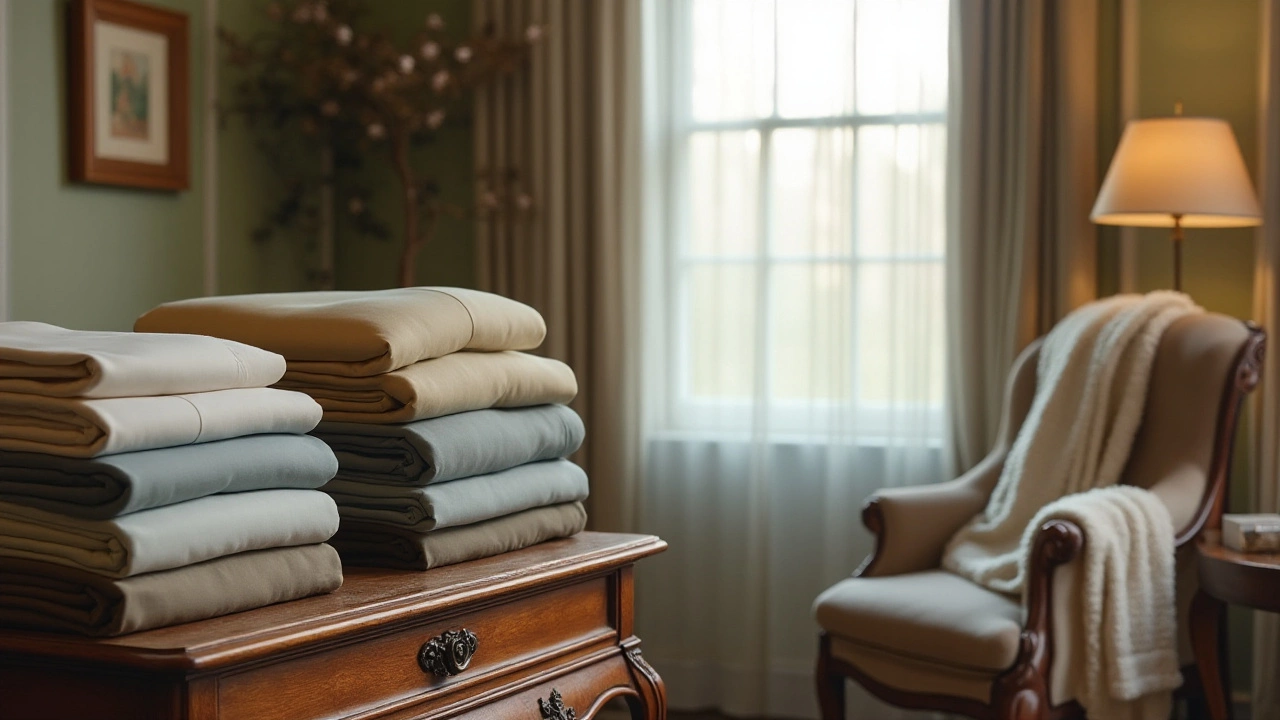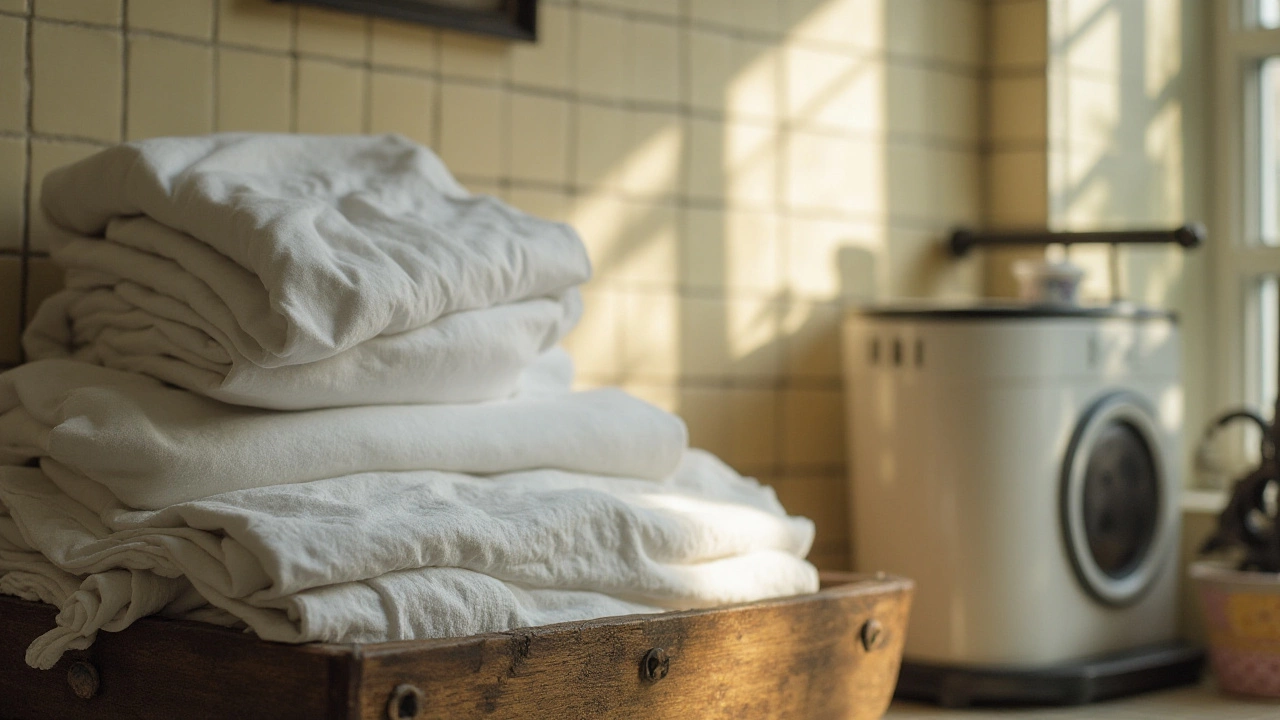How to Choose the Perfect Number of Bed Sheets for Your Home
 Jan, 25 2025
Jan, 25 2025
Choosing the right number of bed sheets can transform your sleep experience and add a touch of luxury to your home. While it might seem like a simple decision, several factors come into play.
From how often you change your sheets to the range of sleepscapes you enjoy, understanding how to balance these elements is key. Whether you're stocking up for a bustling household or setting up a serene space for yourself, finding that sweet spot will ensure you're always prepared.
This guide will delve into essential considerations, helping you make choices that reflect both your lifestyle and personal taste. By the end, you'll have a clearer vision of how many sheets suit your needs and some handy tips to keep them in top condition.
- Understanding Your Bedding Needs
- Factors Affecting Sheet Quantity
- Types of Bed Sheets to Consider
- Care and Maintenance Tips
- Maximizing Linen Longevity
Understanding Your Bedding Needs
When considering how many bed sheets you should have, it is essential to first evaluate your unique lifestyle and preferences. The number of sheets you need depends on a variety of factors. Do you live in a bustling family household, or are you setting up a simple single-person space? Large families might require multiple sets per bed, while a couple may find that two or three sets are plenty. Consider how often you do laundry. If you're washing your sheets weekly, having at least two sets per bed allows you to rotate and always have a fresh set ready as one dries. If you have a hectic schedule and tend to delay laundry, opting for three or more sets might be wise.
Climate and changing seasons also play an important role in deciding your bedding needs. Lighter, breathable sheets like cotton are perfect for warmer seasons, while warmer materials like flannel or linen offer comfort during colder months. In regions where temperatures fluctuate frequently, you might even consider a mix of materials to cover all bases. Your skin type or any allergies to fabric also should influence your choice, as hypoallergenic materials can greatly improve your sleep quality when allergies are a concern. Irrespective of the seasonal needs, always ensure your bed sheets are easy on the skin, emphasizing comfort and durability.
Entertaining guests frequently can increase the number of sheets needed, especially if you have a dedicated guest room. The rule of thumb here would be two sets per guest bed; however, an additional set acts as a safety net for unexpected visitors. Quality always matters more than quantity, but in the case of guest beds, peace of mind comes with preparedness too. As expert interior designer Jane Lockhart puts it,
Investing in quality bed sheets is investing in a good night's sleep. It's essential you have the right numbers to stay comfortable and keep your linens fresh.Decisions about sheets become easier with insights from professionals, making it valuable to consider expert opinions when planning your linen purchases.
A table presenting different sheet types and their seasonal suitability can further aid in simplified decision-making.
| Sheet Type | Winter | Summer |
|---|---|---|
| Cotton Percale | ◎ | ◎◎◎ |
| Cotton Sateen | ◎◎◎ | ◎ |
| Flannel | ◎◎◎◎ | ○ |
| Linen | ◎◎ | ◎◎◎ |
In the end, deciphering your bed sheet requirements is a bit of introspection paired with practical foresight. Consider all these multifaceted aspects, and you'll be well on your way to curating an impressive collection that caters perfectly to your home—and sweet dreams!
Factors Affecting Sheet Quantity
Deciding how many bed sheets to keep in your closet is influenced by several dynamics. One of the primary considerations revolves around your laundry habits. If you're someone who prefers freshly laundered sheets every week, then it's smart to stock up so you're never caught short. In this scenario, having at least three sets per bed allows a smooth rotation: one on the bed, one in the wash, and one ready for use. On the other hand, if laundry day comes every couple of weeks, you may find two sets per bed a sufficient number. This not only ensures a tidy cycle but also reduces wear and tear, as sheet rotation leads to less frequent washes, increasing longevity.
The climate in which you live can also play a significant role. In warmer regions like Auckland, residents might lean towards lighter sheets made of breathable fabrics such as cotton or bamboo, which are also easier to wash and dry quickly. Hence, having multiple sets enables efficient adaptation to changing weather, ensuring comfort in the summer when sweat absorption is vital. Conversely, in colder climates, you might opt for thicker fabrics like flannel or fleece. Here, fewer sets might suffice due to less frequent changes. A commonly referenced expert advice by textile specialist Laura Jacobs states:
"A versatile collection of sheets caters to different seasonal needs, offering both comfort and practicality throughout the year."
For those with frequent guests, guest rooms demand attention in this discussion. It's wise to keep an extra set or two in readily available storage since last-minute visitors can always pop by. This ensures hospitality standards are consistently maintained. Sleep spaces can also dictate the number of sheets. Master bedrooms warrant a different approach than children’s rooms. Kids often necessitate more frequent changes due to nighttime accidents or simply because children enjoy exploring their artistic talents everywhere, even in bed. Parents usually find at least three or four sets per child a manageable number.
Another subtle yet crucial factor is personal aesthetic. If you savor the freedom of changing decor with the seasons or simply love incorporating new colors and patterns into your home environment, a bigger stockpile of sheets caters to your creative instincts. Investing in a diverse range of patterns and prints helps transform your space with little effort, offering a stylistic refresh that keeps your surroundings lively. This doesn't just apply to the master bedroom; even guest rooms can benefit from a bit of designer flair. Anecdotal evidence suggests that even subtle changes to visual elements in the sleeping area can significantly impact mood and relaxation levels.
Storage considerations also weigh heavily on some households. Not everyone has the luxury of a spacious linen closet, so if space is a premium, it might be more practical to pare down. Clever storage solutions can maximize minimal areas, but too many sheets could lead to overcrowding and make the linens difficult to access and manage. This logistical aspect often inspires homeowners to limit quantities, emphasizing quality over quantity, ensuring that what you have is exquisite and serviceable.

Types of Bed Sheets to Consider
When choosing bed sheets, the variety available can be both exciting and overwhelming. The market is brimming with diverse types of sheets, each catering to different preferences, needs, and budgets. One of the most popular options is cotton, known for its breathability and softness. Cotton sheets are durable, easy to care for, and offer comfort all year round. Among cotton sheets, Egyptian cotton reigns supreme due to its long fibers, which lend themselves to a silky texture and superior durability. Pima cotton, a slightly less expensive alternative, also offers a similar luxurious feel but may not boast the same longevity. If you're in a humid climate, you might want something especially breathable, like percale, known for its crisp and lightweight characteristics. Meanwhile, those in chillier climes might lean towards sateen, which provides a heavier, warmer feel perfect for cold nights.
Another contender is bamboo sheets, which have garnered popularity for being environmentally friendly and hypoallergenic. Bamboo sheets are silky to the touch, highly breathable, and possess moisture-wicking attributes, keeping you dry and comfortable throughout the night. If you're someone who values sustainability, bamboo might just align with your values. In fact, some studies suggest that bamboo sheets can last 2-3 years longer than conventional cotton sheets. On the other hand, linen sheets, traditionally seen as a luxurious choice, offer unmatched cooling during summer and coziness in winter. Though initially scratchier compared to other fabrics, linen softens over time and is praised for its durability, absorbing twice as much moisture as cotton, which makes it ideal for hot sleepers.
Microfiber sheets, made from finely woven synthetic fibers, present another choice with their budget-friendly price and ease of care. These sheets are resistant to wrinkles and stains, making them a practical option for a busy household. However, one must be cautious as microfiber can trap heat, which is something to consider depending on your local climate or personal sleep preferences. For those seeking opulence, silk sheets might just be the pinnacle of luxury. Naturally hypoallergenic and gentle on the skin, silk sheets provide an elegant aesthetic and unparalleled softness. A downside, however, is the maintenance required to keep them in pristine condition. They often require delicate washing techniques or professional cleaning.
When selecting the right type of bed sheet for your home, prioritize what's most important for you—be it texture, sustainability, warmth, or ease of care. Personal comfort should always be the guiding factor. As you navigate through your options, remember that your choice of bed sheets can significantly impact your quality of sleep, and therefore, should be approached with the same thoughtful consideration you might give to choosing the right mattress or pillow.
Care and Maintenance Tips
Caring for your bed sheets not only prolongs their life but also enhances the quality of your sleep. Regularly maintained sheets provide a cozy retreat after a long day, while neglected ones might do more harm than good. The journey of maintaining your sheets starts with understanding the material they are made of, as different fabrics require varied washing techniques. Cotton, for example, is quite durable and can withstand higher temperatures, making it easy to keep hygienic. In comparison, more delicate fabrics like silk demand cooler water and gentle detergents to avoid damage. The choice of detergent is equally crucial; harsh chemicals can wear down fibers and fade vibrant colors over time. Instead, mild, eco-friendly detergents are recommended, especially for those conscious of allergic reactions.
Aside from washing, drying your home linens correctly will also affect their longevity. While it might be tempting to toss everything in the dryer, this method can be abrasive to some materials, especially when used excessively. Air drying your sheets not only conserves energy but also imparts that fresh, outdoor scent that many find delightful. When machine drying is necessary, use the lowest heat setting to prevent shrinking and preserves the elasticity of the fabric. An insider tip shared by fabric experts is to dry your pillowcases separately from the bed sheets. This not only ensures even drying but also limits wear and tear on the fabric edges during the tumbling cycle.
"Proper care of your bedding is one of the keys to a good night's sleep," notes Dr. Sophie Elliott, a renowned sleep specialist. "Ensuring your living environment is clean and fresh can significantly impact not just how you sleep, but your overall health as well."
Ironing is another debated maintenance step for bedding tips. While some see it as an unnecessary hassle, ironed sheets have a smoother surface that's less prone to bacterial accumulation, offering an added layer of cleanliness. However, if you choose to skip ironing, folding the sheets neatly as soon as they are dry and tucking them away in a cool, dry place helps maintain their texture. Storing them properly is as important as cleaning them. A well-ventilated linen closet with a sachet of lavender or cedar blocks keeps away unwanted pests and infuses a gentle fragrance into your bedroom essentials.
Remember, occasional deep-cleaning practices can substantially extend the life of your bedding. Consider a bi-annual bleach soak for white sheets to keep them from yellowing, but ensure it's thoroughly rinsed out to prevent damage. While many dismiss these steps as an overuse of resources initially, the value they add to your investment is hard to ignore. In fact, studies show that households practicing regular linen care manage to preserve their sheets up to 50% longer than those who don't, a fact which can bring long-term financial benefits. Armed with these insights and practices, maintaining your sheets goes beyond functionality and enters the realm of creating a sanctuary for rest and rejuvenation.

Maximizing Linen Longevity
When it comes to getting the most out of your bed sheets, taking good care of your linens is just as important as choosing the right ones. Proper maintenance not only ensures they remain soft and comfortable but also helps in keeping their color and integrity intact. Let's face it, no one wants to see their favorite set of sheets fade or fray prematurely. One key aspect is washing them correctly. Always begin by checking the care label on your sheets. This little tag is a goldmine of information, providing specific washing instructions tailored to the material. Wash your sheets in cold water when possible to prevent color bleeding and to preserve the fibers.
Additionally, consider the type of detergent you are using. A gentle detergent is usually best, and it’s always a good idea to use only the recommended amount. Overdoing it can lead to detergent build-up, which may cause skin irritation and leave residues on the sheets. When drying, try air drying them on a clothesline when the weather permits. Not only is this energy-saving, but it also reduces the wear-and-tear that comes with tumble drying. If air drying isn’t practical, use a low heat setting in your dryer and remove the sheets promptly to prevent wrinkles.
"Invest in your sleep and take care of your linens like they’re a luxury, because they are," advises renowned textile expert Clara Johnson.
Beyond washing and drying, storing your sheets correctly can extend their life too. Make sure they are completely dry before folding to avoid mildew formation. Store them in a cool, dry place away from direct sunlight, which can cause colors to fade. To keep things fresh, consider placing a sachet of dried lavender or cedar balls in your linen closet to deter moths and impart a pleasant aroma. Rotate your collections to ensure even wear across all your sets. This might mean using each set once every couple of weeks if you have a few on hand. By rotating, each set has time to ‘rest’, which surprisingly boosts longevity.
Here's a basic routine to follow for keeping your bed sheets in prime condition:
- Wash them every one to two weeks, depending on your preference and local climate.
- Promptly treat any stains using a mixture of water and vinegar before washing.
- Be aware of the fabric type. Cotton sheets might need different care compared to silk or linen.